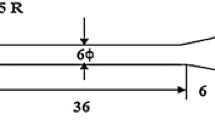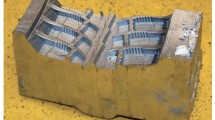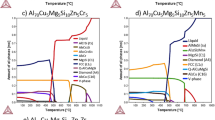Results of a study aimed at formation of a single-phase fine-grained structure in pistons from aluminum alloy V95 in the process of their fabrication, which involves isostatic pressing of liquid metal before the start of crystallization, application of pressure to the crystallizing metal, and holding under pressure in the process of cooling to the shop temperature, are presented. The ultimate strength and the structure of alloy V95 after casting with imposition of pressure are determined. An example of application of the method suggested for fabricating cast billets ∅ 82 × 70 mm in size with a uniform dense structure without gas shrinkage defects, volume and dendritic segregation is considered.
Similar content being viewed by others
Avoid common mistakes on your manuscript.
Introduction
The mechanism of hardening of aluminum alloys of type V95 is based on precipitation of intermetallic phases (MgZn2, Al2Mg3Zn3, Al2 CuMg etc.) from the solid solution. The hardening effect depends considerably on the fineness of the excess phases and uniformity of their distribution within individual grains [1].
The aim of the present work was to create conditions of structure formation in alloy V95, under which the precipitation of the hardening phases from the solid solution is controllable from the start of pouring of the liquid metal and its subsequent high-pressure crystallization to the moment when stabilization of the properties is detected at this or that temperature.
Methods of Study
A blend from rolled commercial alloy V95 was melted in an electric resistance furnace under a layer of flux. The temperature of the metal was controlled with the help of a platinum-rhodium-platinum thermocouple accurate to ±5°C.
The metal was poured through a bowl with a stopper into a steel mold heated to the temperature specified accurate to ±10°C. Before lifting the stopper, the cavity of the mold was connected to an evacuating system with residual pressure 0.01 ± 0.05 MPa. These measures provided stabilization of the modes of filling of the mold.
The varied parameters were the temperature of the poured metal, the level of the pressure applied to the liquid and crystallizing metal, and the temperature of the mold before the pouring. The obtained ingots with a size ∅ 80 × 60 mm were cut into specimens for studying the structure and determining the physical and mechanical properties.
The tensile tests of the specimens were conducted in a WDW-100E computer-controlled universal electromechanical testing machine. All the specimens had the same geometric sizes.
Choice of Modes of Application of Pressure
The posed task of formation of a structure providing advanced properties can be solved on the basis of an “integrated process,” i.e., a process combining casting, pressure crystallization and temperature-time treatment.
The problem of controlled formation of structure in massive enough ingots (in our case the wall thickness was 40 mm and more) is the fact that cooling of the metal and its crystallization develop at different rates in sections located at different distances from the surface of contact with the mold. This gives rise to such flaws as segregation, difference in grain sizes, looseness and porosity in interdendritic spaces.
These flaws are removed by labor- and power-intensive operations of pressure treatment.
The studies performed in [2] have shown that the effect of the rate of cooling of the metal can be reduced to a minimum by imposing an appropriate external pressure. In the first approximation, the considered model of the effect of the pressure was purely mechanical. Direct measurements of the volume of liquid metal have shown that under a pressure exceeding 300 MPa the relative decrease in the volume (the compressibility) may attain 13% [3, 4].
We presume that a considerable part of this change in the volume is connected with approach of atoms to the distance of action of the forces of mutual repulsion.
The experimental oscillograms of the process of pressing of the metal exhibit cases of “repulsion” of the pressing plungers at the moment of stop of feeding of the working liquid into the hydraulic cylinders. This circumstance should be taken into account due to the following considerations: (1) under the action of elastic forces the effect of the pressure may propagate to some distances, and (2) when the atoms move close enough to each other under the action of a high pressure, i.e., in a situation when the volume of the liquid prior to the crystallization virtually does not differ from its volume after the end of this process, the mutual positions of atoms may be equivalent or close to those before the crystallization.
Thus, we may speak about formation of nonequilibrium or very nonequilibrium structures.
In practice, the possibility of proximity of atoms has not been considered for such processes as pressure casting, liquid forging, or casting with crystallization under pressure. For example, in liquid forging the pressure under the crust of the crystallized metal decreases; the mobility of atoms is responsible for a separating diffusion, formation and interaction of phases, and predetermines the occurrence of structural and phase transformations by an equilibrium mechanism with decomposition of the solid solution and precipitation of excess phases under cooling below the solidus line.
In an ideal variant, future development of science and technology may provide application of pressure to some critical level, when the location of atoms in the whole of the volume of an ingot or a casting will possibly be fixed as an immobile, “frozen,” structureless and amorphous. Then excess hardening phases would precipitate independently of the structure formed in the liquidus-solidus range.
However, such a state of a metal has not been implemented yet either in Russia or in other countries.
Results and Discussion
The stress-strain curves of alloy V95 obtained in the tensile tests after application of various pressures during crystallization are presented in Fig. 1. Below we give the values of the ultimate strength (σr) of cast alloy V95 obtained with application of pressure p in crystallization.
p, MPa | σr, MPa | |
0 | . . . . . . . . . . . . . . . . . . . . | 90 |
200 | . . . . . . . . . . . . . . . . . . . . | 193 |
300 | . . . . . . . . . . . . . . . . . . . . | 199 |
400 | . . . . . . . . . . . . . . . . . . . . | 199 |
500 | . . . . . . . . . . . . . . . . . . . . | 220 |
It can be seen that the cast specimen obtained without application of pressure has the lowest strength. After crystallization under pressure the value of σr of alloy V95 is more than doubled.
The microstructure of the cast alloy obtained without application of pressure in crystallization is presented in Fig. 2 a. For comparison, we give in Fig. 2 b the microstructure of the alloy after rolling and in Fig. 2 c the microstructure in cast condition after crystallization at a pressure of 500 MPa.
The improvement of the mechanical properties under the effect of pressure may be connected first of all with densification of the metal at the places of location of micropores and microscopic looseness, and with the motion of dislocations over slip planes [5, 6].
The principal difference in the structure of alloy V95 after deformation and after casting with crystallization under pressure (Fig. 2 b and c) consists in the sizes of the dendrite cells and in the patterns of distribution of the excess phases.
Application of a high enough pressure has made it possible to form a homogeneous structure both at the surface and in the center of the ingot. In contrast to the rolled state, the anisotropy of properties in the material with such a structure can be reduced to a minimum.
We should pay attention to the absence of grain boundaries. The dendrite cells are pressed densely over straight lines and off-oriented at an angle of about 120°, which allows us to speak about the bulk nature of the crystallization from individual centers which grow and squeeze the phases on the boundaries of cells. However, excess phases are observable on not every grain boundary, which may be connected with formation of a supersaturated solid solution in the cells.
Control of pressure in all the stages of formation of structure should be aimed at keeping such process modes where the alloying elements (Cu, Mg, Zn etc.) would stay, if possible, in the solid solution. By choosing the temperature and the time of the hold in the process of cooling of the casting in the mold we can initiate decomposition of the solid solution in the temperature range providing a high fineness and, hence, a high efficiency of the hardening phases.
Conclusions
-
1.
Application of pressure to the liquid and crystallizing metal may be used for forming a homogeneous structure in massive walls of ingots and castings including those produced from deformable heat-hardenable aluminum alloys.
-
2.
The pressure not only densifies the growing crystals by removing the defects caused by gas shrinkage and segregation, but also suppresses the diffusion redistribution of the components of the alloy. This may be used in an integrated process of casting with application of pressure and subsequent temperature-time treatment in the solidus-room temperature range, when the fine hardening phases precipitate inside the dendrite cells and not only on their boundaries.
-
3.
The suggested integrated process of temperature-time treatment of deformable aluminum alloys has been tested successfully in the production of casings for pressure regulators of space launch complexes designed for a pressure of 40 MPa, and casings for gas engineering articles. The obtained preforms with a size of ∅ 80 × 60 mm may be recommended for the production of pistons of augmented internal combustion engines.
References
V. F. Korostelev, Surface and Volume Hardening of Alloys [in Russian], Izd. “Novye Tekhnologii,” Moscow (2013), 208 p. (ISBN 978-594694-022-1).
V. K. Afanas’ev and A. N. Prudnikov, “An aluminum alloy with low thermal expansion,” Metallurg. Mashinostr., No. 4, 103 – 107 (2005).
M. S. Denisov, “A study of compression of aluminum alloys under application of pressure to the crystallizing metal,” Mash., Tekhnol., Mater., No. 3, 46 – 49 (2014).
V. F. Korostelev, L. P. Khromova, and A. N. Rasskazchikov, “Control of the process of crystallization of alloy V95,” Mekhatron., Avtomat., Upravl., No. 8, 18 – 24 (2009).
A. Zhilyaev and A. Pshenichnyuk-Oxford, Superplasticity and Grain Boundaries in Ultrafine-Grained Materials, Cambridge Int. Science Publishing Ltd. (2011), 326 p.
S. Ghosh, D. Dimiduk, and S. Ghosh, Computational Methods for Microstructure-Property Relationships, Springer, New York (2011), 675 p.
Author information
Authors and Affiliations
Corresponding author
Additional information
Translated from Metallovedenie i Termicheskaya Obrabotka Metallov, No. 2, pp. 18 – 20, February, 2017.
Rights and permissions
About this article
Cite this article
Korostelev, V.F., Khromova, L.P. & Denisov, M.S. Analysis of Dependence of the Properties of Alloy V95 on the Pressure Applied to Crystallizing Metal. Met Sci Heat Treat 59, 82–84 (2017). https://doi.org/10.1007/s11041-017-0107-z
Published:
Issue Date:
DOI: https://doi.org/10.1007/s11041-017-0107-z






